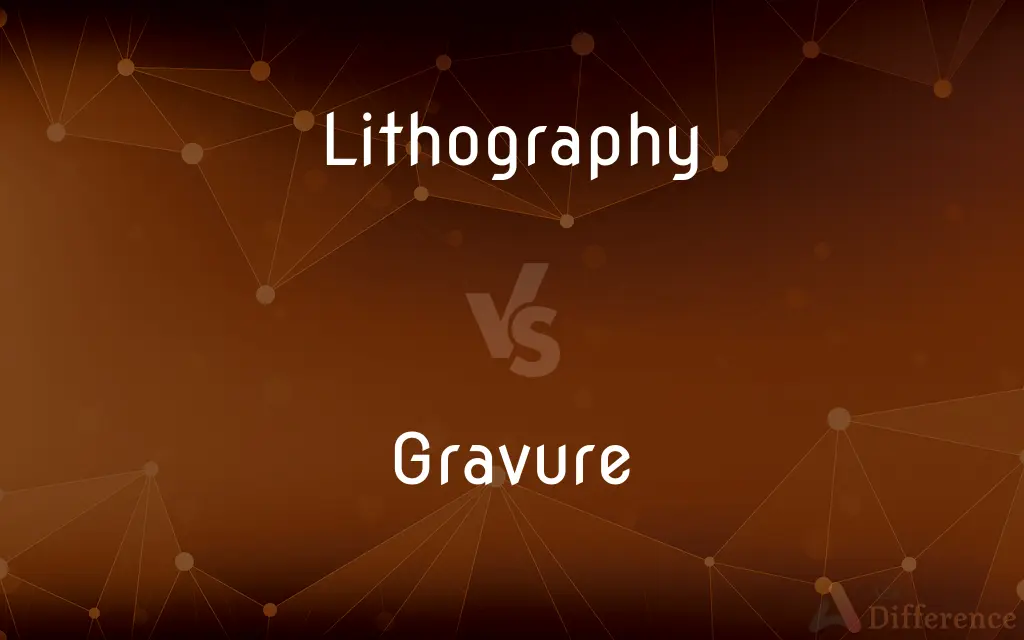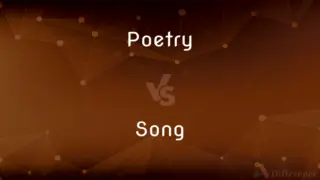Lithography vs. Gravure — What's the Difference?
By Tayyaba Rehman & Maham Liaqat — Updated on April 26, 2024
Lithography involves printing from a flat surface treated to repel ink except where needed, while gravure printing uses engraved plates for high-quality, detailed images.

Difference Between Lithography and Gravure
Table of Contents
ADVERTISEMENT
Key Differences
Lithography, a printing process based on the principle of oil and water repulsion, creates images on a flat surface. Whereas, gravure, also known as rotogravure, involves engraving the image onto a cylinder, making it ideal for high-volume runs of magazines, catalogs, and packaging.
In lithography, the image area accepts ink while the non-image areas repel ink, using a chemical process. On the other hand, gravure printing involves etching images into metal plates, filling these recesses with ink, and then transferring the ink directly onto the printing substrate.
Lithography is suitable for shorter runs with variable images, such as books or fine art reproductions, due to its flexibility in setup and changeover. In contrast, gravure is preferred for long runs due to its ability to produce consistent, high-quality prints over large volumes without significant degradation.
While lithography offers the advantage of producing high-quality prints with good color control, gravure excels in achieving deeper and more durable color saturation, making it superior for printing photographic and fine art detail.
Lithography generally incurs lower production costs for small to medium volumes, while gravure's initial setup costs are higher, but it becomes cost-effective at very large volumes due to the durability and reusability of the engraved cylinders.
ADVERTISEMENT
Comparison Chart
Printing Surface
Flat plate
Engraved cylinder
Ink Application
Chemical process repels ink in non-image areas
Ink fills engraved areas and is directly transferred
Preferred Use
Shorter runs, variable images
Long runs, consistent image requirements
Color Control
High-quality color control, suitable for art prints
Superior in color saturation and detail
Cost Effectiveness
More cost-effective for small to medium runs
Cost-effective in high volumes due to cylinder reusability
Compare with Definitions
Lithography
Suited for small to medium print volumes.
Many artists choose lithography for limited edition prints.
Gravure
A high-volume printing method using engraved cylinders.
Gravure is favored for large-scale magazine production.
Lithography
Flexible in changing images between print runs.
Lithography allows publishers to update book covers easily.
Gravure
Uses direct ink transfer for durability.
Gravure printing is durable enough for wallpaper and vinyl flooring.
Lithography
A printing process using a flat surface where ink adheres only to the design areas.
Lithography is popular for creating original art prints.
Gravure
Ideal for long, consistent print runs.
Gravure machines run efficiently for millions of impressions.
Lithography
Involves a chemical process to separate oily and watery substances.
Modern lithography relies heavily on chemical balance.
Gravure
Higher initial setup costs but economical for large quantities.
While costly to start, gravure reduces costs per page over time.
Lithography
Known for excellent color control.
Lithography is preferred when precise color matching is required.
Gravure
Characterized by its ability to print fine detail and deep colors.
Luxury packaging often employs gravure for its quality.
Lithography
Lithography (from Ancient Greek λίθος, lithos 'stone', and γράφειν, graphein 'to write') is a method of printing originally based on the immiscibility of oil and water. The printing is from a stone (lithographic limestone) or a metal plate with a smooth surface.
Gravure
Short for photogravure
Lithography
A printing process in which the image to be printed is rendered on a flat surface, as on sheet zinc or aluminum, and treated to retain ink while the nonimage areas are treated to repel ink.
Gravure
A method of printing with etched plates or cylinders; intaglio printing.
Lithography
The process of printing an image by drawing the image with a water-repellent material onto a hard, flat surface (typically metal), then copying the surface by applying water and ink (or the equivalent) to it and pressing another material against it.
Gravure
Photogravure.
Lithography
The art or process of putting designs or writing, with a greasy material, on stone, and of producing printed impressions therefrom. The process depends, in the main, upon the antipathy between grease and water, which prevents a printing ink containing oil from adhering to wetted parts of the stone not covered by the design. See Lithographic limestone, under Lithographic.
Gravure
A plate used in the process of gravure.
Lithography
A printing process for reproducing images, using any flat surface, such as a metal plate, in a manner similar to lithography{1}.
Gravure
A reproduction produced by gravure.
Lithography
The process of producing patterns on semiconductor crystals by exposing photosensitive coatings on a matrix, such as silicon, to light patterns in the form desired for the circuit, and subsequently treating (e.g., chemically) the patterns thus formed in such a way as to create integrated semiconductor circuits with the desired properties. This is the principle method (1990's) to create the high-density integrated circuits used in the digital computers on which you are reading this.
Gravure
A type of intaglio printing process, in which an image is engraved onto a rotating copper cylinder.
Lithography
A method of planographic printing from a metal or stone surface
Gravure
(Japan) A style of Japanese softcore; glamour photography.
Lithography
The act of making a lithographic print
Gravure
A printing process that uses an etched or engraved plate; the plate is smeared with ink and wiped clean, then the ink left in the recesses makes the print
Gravure
A printing plate used in the process of gravure
Gravure
An intaglio print produced by gravure
Gravure
Intaglio printing
Common Curiosities
What is lithography?
Lithography is a printing process where ink adheres only to designated image areas on a flat printing plate.
How do lithography and gravure differ in ink application?
Lithography uses a chemical process to repel ink from non-image areas, whereas gravure involves filling engraved areas with ink for transfer.
What type of products are typically produced using gravure printing?
Products such as magazines, large catalogs, and high-volume packaging materials are typically produced using gravure.
Which is more cost-effective for small print runs?
Lithography is more cost-effective for small to medium print runs.
How do setup costs compare between lithography and gravure?
Setup costs for lithography are generally lower compared to the high initial costs associated with preparing engraved cylinders for gravure.
Which printing process is faster?
Gravure typically offers faster processing speeds for long runs due to the continuous nature of the engraved cylinder.
What is gravure?
Gravure is a printing technique that uses engraved cylinders to produce high-quality prints, especially suitable for long runs.
Can gravure print on different materials?
Yes, gravure can print on a variety of substrates including paper, cardboard, and plastic films.
Why might an artist choose lithography over gravure?
An artist might choose lithography for its ability to produce flexible, high-quality color prints in limited editions.
What makes lithography suitable for fine art?
Its excellent color control and the quality of detail it can reproduce make lithography suitable for fine art prints.
Can lithography use digital technology?
Yes, digital lithography combines traditional techniques with digital technology, allowing for variable data printing and shorter setup times.
Why would a publisher choose lithography for books?
Publishers often choose lithography for its flexibility in print runs and superior color and detail control, which are crucial for book production.
How does the durability of prints compare between lithography and gravure?
Gravure prints are generally more durable due to the deeper ink penetration and robust printing process.
Is gravure environmentally friendly?
While gravure printing is efficient, the use of solvents and inks may raise environmental concerns; however, advancements in eco-friendly technologies are improving its sustainability.
What is the main disadvantage of gravure compared to lithography?
The main disadvantage of gravure is its higher initial cost and less flexibility in changing print designs frequently.
Share Your Discovery

Previous Comparison
Fence vs. Railing
Next Comparison
Poetry vs. SongAuthor Spotlight
Written by
Tayyaba RehmanTayyaba Rehman is a distinguished writer, currently serving as a primary contributor to askdifference.com. As a researcher in semantics and etymology, Tayyaba's passion for the complexity of languages and their distinctions has found a perfect home on the platform. Tayyaba delves into the intricacies of language, distinguishing between commonly confused words and phrases, thereby providing clarity for readers worldwide.
Co-written by
Maham Liaqat













































